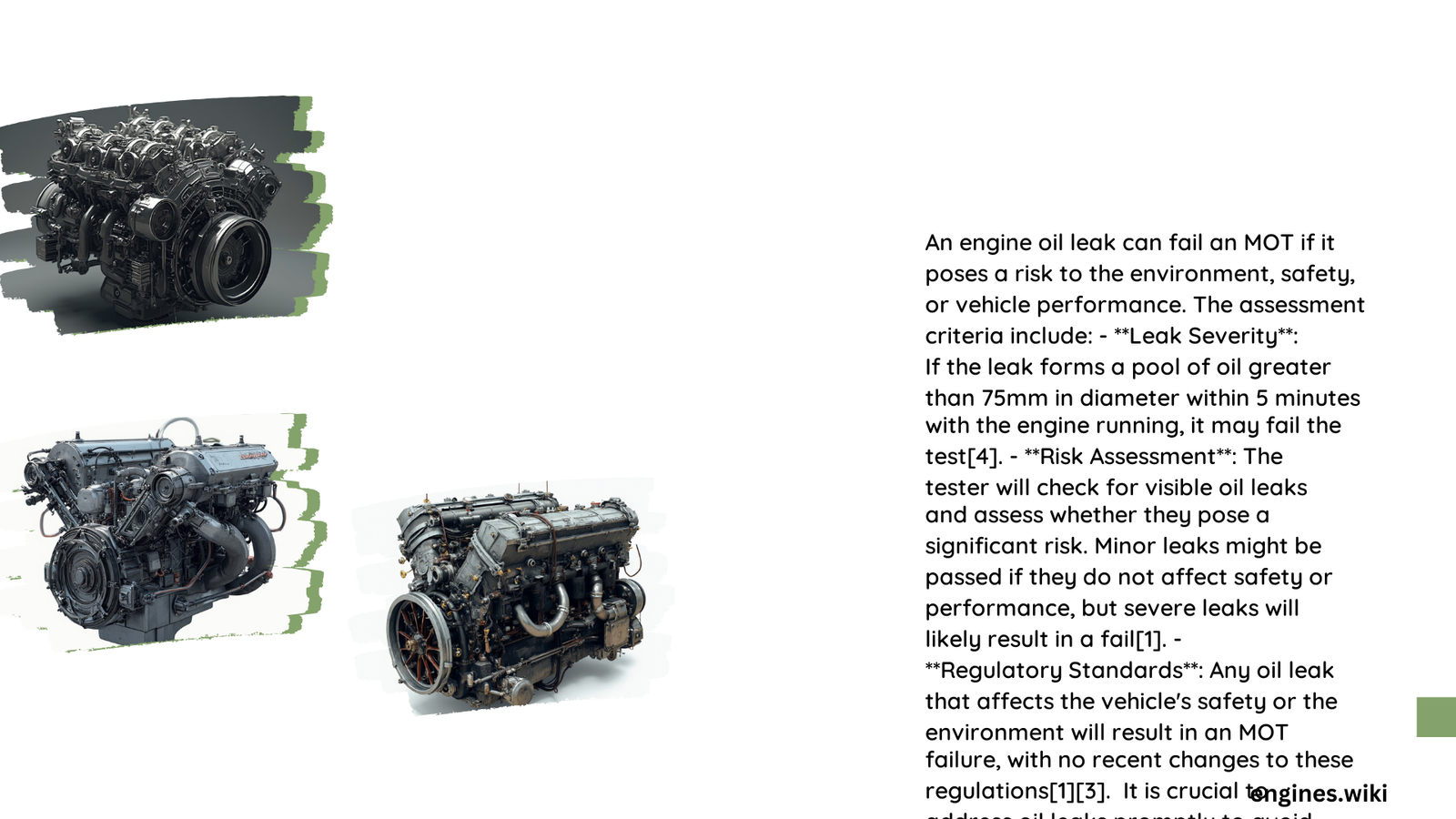Engine oil leaks can be a significant concern for vehicle owners, especially when it comes to passing the MOT test. This guide explores the impact of oil leaks on MOT results, inspection criteria, repair costs, and detection methods. Understanding these factors can help you prepare your vehicle for the MOT and avoid unexpected failures due to oil leaks.
What Are the MOT Guidelines for Engine Oil Leaks?
The MOT test includes specific guidelines for assessing engine oil leaks:
- Inspection Focus: Testers examine the engine, gearbox, and final drive for oil leaks.
- Failure Criteria:
- A pool of oil on the floor exceeding 75mm in diameter within 5 minutes
- Multiple smaller leaks collectively matching this rate
- Risk Assessment: Leaks are evaluated for environmental and safety risks
Detailed MOT Failure Conditions
| Condition | Result |
|---|---|
| Oil pool > 75mm diameter in 5 minutes | Fail |
| Multiple leaks equaling above rate | Fail |
| Leak posing environmental/safety risk | Fail |
| Minor seepage without drips | Pass |
How Much Does Oil Leak Inspection and Repair Cost?

Understanding the costs associated with oil leak inspection and repairs can help you budget for potential issues:
- Inspection Duration: Part of the 45-60 minute MOT test
- Repair Costs:
- Gasket/seal replacement: £50-£200
- Oil line repair/replacement: £100-£300
- Oil pan/drain plug replacement: £150-£500
- Other repairs (e.g., oil cooler seal): £150-£500
Factors Affecting Repair Costs
- Severity of the leak
- Location of the leak
- Vehicle make and model
- Labor rates in your area
What Percentage of Vehicles Fail MOT Due to Oil Leaks?
While exact statistics are not available, oil leaks are frequently cited as a common reason for MOT failures. Factors influencing failure rates include:
- Vehicle age
- Maintenance history
- Type of oil used
- Driving conditions
How Are Engine Oil Leaks Detected During MOT?
MOT testers employ several techniques to detect and assess oil leaks:
- Visual Inspection: Examining the engine, gearbox, and differential with the engine idling
- Measurement: Assessing the size of oil pools on the floor
- Dye Testing: Using special dyes to identify leak sources
- Pressure Testing: Applying pressure to the system to reveal leaks
DIY Leak Detection Methods
- Regular oil level checks
- Inspecting the ground where you park
- Using cardboard under the vehicle to spot leaks
- Keeping the engine clean for easier leak identification
Can Minor Oil Seepage Pass MOT?
Minor oil seepage can often pass the MOT test under certain conditions:
- No active dripping or pooling of oil
- Seepage doesn’t pose environmental or safety risks
- Overall oil loss is minimal
However, it’s important to monitor even minor seepage as it can worsen over time.
What Are Common Causes of Engine Oil Leaks?
Understanding the causes of oil leaks can help prevent MOT failures:
- Worn gaskets and seals
- Damaged oil pan
- Loose or damaged oil filter
- Cracked engine block or cylinder head
- Deteriorated valve cover gaskets
- Faulty oil lines or connections
Preventive Measures
- Regular oil changes
- Using high-quality oil and filters
- Addressing minor leaks promptly
- Following manufacturer maintenance schedules
How Can You Prepare Your Vehicle for MOT Oil Leak Inspection?
To increase your chances of passing the MOT oil leak inspection:
- Conduct a pre-MOT inspection
- Clean the engine to make leaks more visible
- Address any known leaks before the test
- Check and top up oil levels
- Inspect and replace worn gaskets or seals
- Consider a professional inspection if you suspect leaks
What Should You Do If Your Vehicle Fails MOT Due to Oil Leaks?
If your vehicle fails the MOT due to oil leaks:
- Review the failure report carefully
- Get a detailed quote for repairs
- Consider a second opinion if repairs seem extensive
- Address the issues promptly to avoid further damage
- Re-test within the allowed timeframe (usually 10 working days)
Post-Repair Steps
- Ensure all leaks are fixed
- Clean the engine thoroughly
- Test drive before the re-test
- Keep repair receipts for the MOT tester
By understanding the MOT criteria for oil leaks and taking proactive measures, you can significantly improve your chances of passing the test and maintaining your vehicle’s roadworthiness.
References:
- https://eastlondonmot.com/blog/does-an-oil-leak-fail-an-mot/
- https://www.theminiforum.co.uk/forums/topic/337840-oil-leaks-and-mots/
- https://www.pistonheads.com/gassing/topic.asp?f=10&h=0&t=1756724
